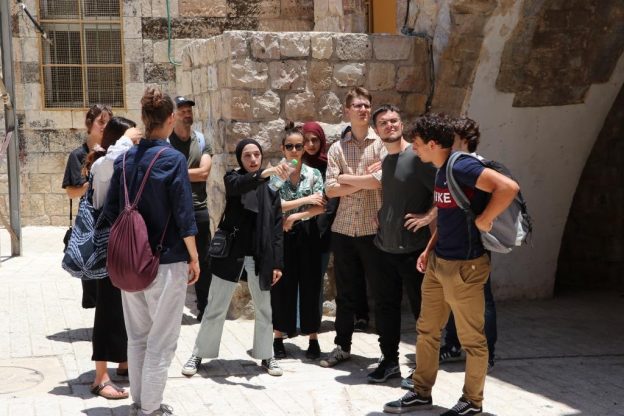What is The West Bank? If you decide to come to Hebron, you will most likely travel from Jerusalem. On your way here, you will pass checkpoints where your papers may be checked, you will see heavily armed entrances to areas where Jewish settlers live, and you will see red signs beside the roads which signify that this area is ‘dangerous’ and ‘forbidden’ for Israelis.
You may wonder: where am I? What is this place? This is the area of historical Palestine which is known as the West Bank, Palestine.
Table of Contents
Key Information
| The area of the West Bank | About 5,860 km² |
| Population | 2,949,246 (July 2021 est.) |
| Traveling | Palestinians who live in the West Bank to travel to the outside world through Jordan |
| Religion | Islam, Judaism, and Christianity |
World War I
The West Bank, Palestine – or Al-Defah Al-Garbiea as it’s known in Arabic – is a geopolitical area located in historical Palestine. It is called the West Bank because it lies west of the Jordan River. The area of the West Bank constitutes approximately 21% of the total area of the Mandate of Palestine (from the river to the sea) – about 5,860 km².
This area includes the Nablus Mountains, the Jerusalem Hills, the Hebron Mountains, and the western Jordan Valley. It forms the remaining Palestinian Territories with the Gaza Strip after Israel’s founding on the rest of Palestine in 1948. From 1517 to 1917, the area was under Turkish rule as part of Ottoman Syria. At the 1920 San Remo conference, the Allies of World War I allocated the area to the British Mandate of Palestine (1920–1948).
Partition Plan
In 1947, the United Nations designated the West Bank as part of a proposed Arab state in the Partition Plan for Palestine. Resolution 181 recommended the dividing of the British Mandate into a Jewish state, an Arab state, and an internationally administered enclave of Jerusalem.
A broader region of the modern-day West Bank was assigned to the Arab state. The resolution designated the territory described as “the hill country of Samaria and Judea” (the area now known as the West Bank) as part of the proposed Arab state, but following the 1948 Arab–Israeli War, this area was captured by Transjordan.
Six-Day War
Israel subsequently occupied the West Bank and Gaza Strip in 1967 after the Six-Day War. In this war, Israel fought against Egypt, Syria, and Jordan. Israel fired the first shot, but claims it was preempting an imminent Egyptian attack. In six days, Israel took the West Bank and East Jerusalem from Jordan.
Israel calls the West Bank by the name of Judea and Samaria. Jewish settlers have been allowed to move into this area ever since 1967, but Palestinians and most of the international community consider it illegally occupied Palestinian land. Around 2.9 million Palestinians live in the West Bank, Palestine along with around 391,000 Israeli settlers.
Control
As part of the Oslo Accords, signed by the Palestine Liberation Organization (PLO) and Israel in 1993 and 1995, the occupied West Bank was divided into areas A, B and C.
1. Area A: Areas under the full control of the Palestinian Authority (security and administrative) which consists of 18% of the total area of the West Bank.
2. Area B: Areas in which the responsibility for public order lies with the Palestinian Authority. Israel has full control over security matters. Area B consist of 18.3% of the total area of the West Bank.
3. Area C: Areas under the full control of the Israeli government, constituting 61% of the total area of the West Bank.
The agreement also led to the establishment of an interim Palestinian government – the Palestinian Authority (PA), which was given limited powers of governance in Areas A and B.
Settlements
The Oslo Accords were meant to kick-start future peace talks, with a two-state solution as the desired objective of negotiations. Instead, the outcomes of the Oslo Accords left Israel in complete control of the Palestinian economy, as well as its civil and security matters in more than sixty percent of the West Bank, designated as Area C. Despite granting the interim government control over administrative and internal security matters in part of the West Bank, Israel maintains military control over the entire area.
Israel has undertaken the further expansion of settlements in the territories occupied since 1967, including parts of East Jerusalem. The United Nations and international rights groups condemned the expansion of settlements, declaring them illegal under international law. The political process between Israel and the Palestinians did not impede settlement activities. The Labor government of Yitzhak Rabin (1992-1996) and all subsequent governments have built thousands of new housing units. As a result, between 1993 and 2000, the number of settlers on the West Bank (excluding East Jerusalem) increased by almost one hundred percent.
Traveling
Palestinians are not allowed to use Israeli airports and they are not allowed to have their own airport. The Al-Karama crossing, or King Hussein Bridge, is the only way for Palestinians who live in the West Bank to travel to the outside world through Jordan. This border crossing has been under Israeli control since 1967 when the Israelis took control of all the Palestinian Territories, including the West Bank and the Gaza Strip.
To travel abroad, Palestinians must go through three different immigration officers: a Palestinian Authority officer, an Israeli and a Jordanian officer on the other side of the crossing. This makes traveling abroad time- and money-consuming. Israel allows Palestinians to travel between the West Bank, Gaza Strip and East Jerusalem only if they obtain a special permit, regardless of whether they are traveling for the purposes of work, medical care, or family visits. These permits are hard to obtain and can take a lot of time.
Tourism
The West Bank contains several of the most significant sites in the world for Muslims, Christians and Jews. Because of this, it is an attractive location for tourists and pilgrims. Palestinians themselves have difficulties in accessing the territory for recreation.
If the Palestinian Dead Sea coastline could be developed in the same way as the Jordanian and Israeli coastline have been, this would give an enormous boost to the Palestinian economy. Israel, however, does not grant permits and often bars Palestinians from entering at their only access point to the sea.
The key Palestinian towns in the West Bank for tourism are East Jerusalem, Bethlehem and Jericho, but due to the many checkpoints and obstacles along the way, many tourists do not attempt to get to these places. By withholding licenses from tour guides, controlling airports and highways, and not giving permits for construction and renovation of hotels, Israel ensures it has a monopoly on tourism.
Concluding thoughts
The West Bank is a part of historical Palestine that has been occupied by Israel since 1967. The land is divided into three areas, with different degrees of Israeli and Palestinian control. At the end of the day Israel has military control over all the West Bank, Palestine meaning its forces can enter all these areas at any time, to detain individuals or raid homes.
The expansion of settlements in the West Bank proceeds at a rapid pace. Although the West Bank is home to many important religious sites for all three monotheistic religions, the tourist sector has had a hard time living up to its full potential due to Israeli infringements. The West Bank, Palestine is the biggest area the Palestinians still have ‘left’, but it is being smothered under the occupation.
Tags: Size of the West Bank



